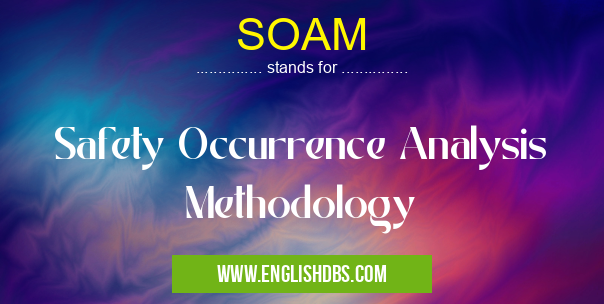What does SOAM mean in UNCLASSIFIED
SOAM stands for Safety Occurrence Analysis Methodology. It is a systematic approach for investigating and analyzing safety occurrences, such as accidents, incidents, or near misses, to identify the underlying causes and develop recommendations for preventing future occurrences.

SOAM meaning in Unclassified in Miscellaneous
SOAM mostly used in an acronym Unclassified in Category Miscellaneous that means Safety Occurrence Analysis Methodology
Shorthand: SOAM,
Full Form: Safety Occurrence Analysis Methodology
For more information of "Safety Occurrence Analysis Methodology", see the section below.
Objectives of SOAM
The primary objectives of SOAM are to:
- Improve safety performance by identifying and eliminating hazards and risks
- Learn from past events to prevent similar occurrences in the future
- Facilitate a comprehensive understanding of safety occurrences and their contributing factors
- Promote a proactive approach to safety management
Key Elements of SOAM
SOAM involves several key elements, including:
- Data collection: Gathering relevant information about the safety occurrence, such as witness statements, physical evidence, and documentation
- Analysis: Identifying the sequence of events leading to the occurrence, as well as the underlying factors that contributed to it
- Root cause analysis: Determining the fundamental causes of the occurrence, beyond immediate or surface-level factors
- Corrective and preventive actions: Developing and implementing recommendations to address the root causes and prevent future occurrences
Benefits of SOAM
Implementing SOAM offers numerous benefits, such as:
- Enhanced safety performance and reduced risk of accidents
- Improved understanding of safety risks and vulnerabilities
- Proactive identification and mitigation of hazards
- Increased organizational resilience and ability to respond to safety challenges
- Compliance with safety regulations and standards
Conclusion
SOAM is a valuable tool for enhancing safety and preventing accidents. By systematically investigating and analyzing safety occurrences, organizations can identify the underlying causes and develop effective strategies to mitigate risks and improve safety outcomes.
Essential Questions and Answers on Safety Occurrence Analysis Methodology in "MISCELLANEOUS»UNFILED"
What is Safety Occurrence Analysis Methodology (SOAM)?
SOAM is a systematic and structured approach to analyze safety occurrences, such as accidents, incidents, and near misses. It aims to identify the root causes of these events and develop effective preventive measures.
What are the key steps involved in SOAM?
The key steps in SOAM typically include data collection, event analysis, root cause identification, and the development of corrective actions.
What types of data are collected during a SOAM analysis?
SOAM analysis involves collecting a wide range of data, including information about the occurrence itself, the context in which it occurred, and any contributing factors. This data can be gathered through interviews, document reviews, and physical inspections.
How does SOAM differ from other safety analysis methods?
SOAM is unique in its focus on the underlying causes of safety occurrences, rather than just the immediate events. It also emphasizes the importance of involving stakeholders from various levels of the organization in the analysis process.
What are the benefits of using SOAM?
SOAM offers several benefits, including:
- Improved understanding of safety risks
- Identification of effective preventive measures
- Enhanced safety culture
- Reduced accident rates
